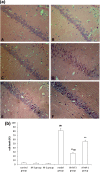Hippocampal neuronal metal ion imbalance related oxidative stress in a rat model of chronic aluminum exposure and neuroprotection of meloxicam
- PMID: 24618126
- PMCID: PMC3995718
- DOI: 10.1186/1744-9081-10-6
Hippocampal neuronal metal ion imbalance related oxidative stress in a rat model of chronic aluminum exposure and neuroprotection of meloxicam
Abstract
Neurodegenerative diseases remain a significant unresolved societal burden afflicting millions of people worldwide. Neurons in the brain are highly sensitive to oxidative stress, which can be induced by metal toxicity. In this paper, a chronic aluminum overload-induced model of neurodegeneration was used to investigate whether metal ions (Al, Fe, Mn, Cu and Zn)-related oxidative stress was involved in neurodegenerative mechanism and to identify the protective action of meloxicam against rat hippocampal neuronal injury. The metal ion contents, activity of superoxide dismutase (SOD), and content of malondialdehyde (MDA) were detected. The results showed that the spatial learning and memory (SLM) function was significantly impaired in chronic aluminum overload rats. Considerable karyopycnosis was observed in hippocampal neurons. The SOD activity was weakened and the MDA content increased both significantly. In the hippocampus, Al, Fe, Mn, Cu, and Zn contents increased by 184.1%, 186.1%, 884.2%, 199.4% and 149.2%, respectively. Meloxicam administration (without Al) had no effect compared with the control group, while meloxicam treatment with aluminum exposure significantly protected rats from SLM function impairment, neuron death, lower SOD activity, higher MDA content and brain metal ion imbalance. Our findings suggest that the cerebral metal ion imbalance-related oxidative stress is involved in mechanism of cerebral injury and neurodegeneration induced by chronic Al overload in rats, and that meloxicam protects neurons by reducing metal ion imbalance-related oxidative stress.
Figures






Similar articles
-
Protective effects of meloxicam on aluminum overload-induced cerebral damage in mice.Eur J Pharmacol. 2006 Oct 10;547(1-3):52-8. doi: 10.1016/j.ejphar.2006.07.031. Epub 2006 Jul 25. Eur J Pharmacol. 2006. PMID: 16928369
-
Misoprostol Reverse Hippocampal Neuron Cyclooxygenase-2 Downstream Signaling Imbalance in Aluminum-Overload Rats.Curr Alzheimer Res. 2016;13(9):1006-16. doi: 10.2174/1567205013666160401114601. Curr Alzheimer Res. 2016. PMID: 27033056 Free PMC article.
-
Beraprost sodium protects against chronic brain injury in aluminum-overload rats.Behav Brain Funct. 2015 Feb 7;11(1):6. doi: 10.1186/s12993-014-0051-7. Behav Brain Funct. 2015. PMID: 25888780 Free PMC article.
-
Metal Ion Imbalance-Related Oxidative Stress Is Involved in the Mechanisms of Liver Injury in a Rat Model of Chronic Aluminum Exposure.Biol Trace Elem Res. 2016 Sep;173(1):126-31. doi: 10.1007/s12011-016-0627-1. Epub 2016 Jan 26. Biol Trace Elem Res. 2016. PMID: 26811106
-
The protection of meloxicam against chronic aluminium overload-induced liver injury in rats.Oncotarget. 2017 Apr 4;8(14):23448-23458. doi: 10.18632/oncotarget.15588. Oncotarget. 2017. PMID: 28423583 Free PMC article.
Cited by
-
Protective Effects of Liquiritin on the Brain of Rats with Alzheimer's Disease.West Indian Med J. 2015 Dec;64(5):468-472. doi: 10.7727/wimj.2016.058. Epub 2016 Apr 29. West Indian Med J. 2015. PMID: 27399208 Free PMC article.
-
The GSK-3β/β-Catenin Signaling-Mediated Brain-Derived Neurotrophic Factor Pathway Is Involved in Aluminum-Induced Impairment of Hippocampal LTP In Vivo.Biol Trace Elem Res. 2021 Dec;199(12):4635-4645. doi: 10.1007/s12011-021-02582-9. Epub 2021 Jan 18. Biol Trace Elem Res. 2021. PMID: 33462795
-
Maternal Prenatal Inflammation Increases Brain Damage Susceptibility of Lipopolysaccharide in Adult Rat Offspring via COX-2/PGD-2/DPs Pathway Activation.Int J Mol Sci. 2022 May 30;23(11):6142. doi: 10.3390/ijms23116142. Int J Mol Sci. 2022. PMID: 35682823 Free PMC article.
-
Isorhynchophylline alleviates learning and memory impairments induced by aluminum chloride in mice.Chin Med. 2018 Jun 14;13:29. doi: 10.1186/s13020-018-0187-8. eCollection 2018. Chin Med. 2018. PMID: 29946349 Free PMC article.
-
Natural compounds attenuate heavy metal-induced PC12 cell damage.J Int Med Res. 2020 Jun;48(6):300060520930847. doi: 10.1177/0300060520930847. J Int Med Res. 2020. PMID: 32552232 Free PMC article.
References
Publication types
MeSH terms
Substances
LinkOut - more resources
Full Text Sources
Other Literature Sources

